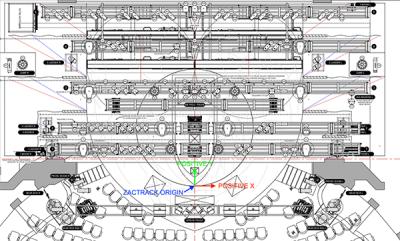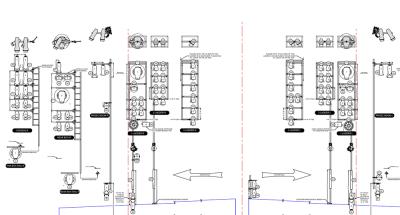Tim Lutkin has already won two prestigious awards for his work on Life of Pi: a Laurence Olivier Award in London, and an Outer Critics Circle Award in New York, both for Best Lighting Design on the extraordinary adaptation of the novel by Yann Martel into a play.
Lutkin is now one of the seven Life of Pi designers nominated for a Tony Award. The nominees are Tim Hatley & Andrej Goulding for scenic design, Tim Hatley, Nick Barnes, and Finn Caldwell for costumes, and Carlyn Downing for sound design. A veteran of more than 20 shows in London’s West End and stints designing for the National Theatre and the Royal Shakespeare Theatre, the UK-based lighting designer got his first taste of Broadway as associate lighting designer for Hugh Vanstone, working on both Matilda and Ghost The Musical. This year he has two shows on Broadway as designer, Life of Pi, which opened in March, and Back To The Future, which will open in July.
Life of Pi is set in several locations, including a boat at sea, and features performances by a team of puppeteers operating a variety of animals, including a tiger. Live Design spoke to Lutkin about his work on the production, which originated at the Crucible Theatre, Sheffield in June 2019, before transferring to the Wyndham’s Theatre in London and then Broadway.


Live Design: What attracted you to this project?
Tim Lutkin: The main thing that attracted me to the project was Tim Hatley, who was also working on it, and it was Tim who called me, initially. I've known Tim for about 15 years and when he said to me it's Life of Pi, I was like, are you completely mad? And especially in Sheffield where it is almost in the round. But you know, like we all say, the challenge is exciting. It was also the commercial appeal of people knowing that book and knowing the film was part of the attraction, and to try to do it justice.
LD: When the show was created, was there an overarching theme or inspiration that the creative team were guided by?
TL: Essentially, as you can see how the show is staged, we start in a hospital room. And then we move to the zoo and then back to the hospital room, then out on the ocean. And there are animals on stage. So, the concept at first was that it could all take place in the hospital room. The room has a lot of projection elements in it, the floor and the back wall, and then all of these shutters open up to create the different worlds. We started by asking if it could all be done in the clinical, bright hospital room with the props etc, or does it need a bigger video concept? We've kind of settled somewhere between the two In terms of lighting, it was very important for me to support the video treatment and pull out all the deep, saturated worlds that the character of Pi goes to in his head when he's describing the story. The initial idea of the hospital room was to make it quite dingy as it's supposed to be an old hospital in Mexico, and then the bright and colorful worlds of the past should contrast with the hospital room. But then we left that vision and the discussion became, how do we solve the problems?
LD: The show is a magical fantasy but you still have to evoke the sea and the environment realistically. How do you help the audience suspend disbelief?
TL: The hospital room concept is strong because we video map onto the hospital floor and wall. The hospital bed always remains on stage and the boat comes up out of the floor and surrounds it. That makes it much easier to start layering in video and lighting. The video content we ended up with is quite realistic when Pi is out at sea, but the video treatment is on an architectural white hospital wall. It's a blessing when a set designer gives you something like that because it locks everybody into a visual.
LD: What are some of the main differences in your designs for London versus Broadway?
TL: There's one major difference for lighting: the scale and size of the New York production is much bigger than London and it's much wider for lighting. We harnessed a new technology called zacktrack which you guys have probably heard of but we didn’t have in London. It meant that in New York we could have up to 32 individual followspots following puppets, (obviously, the animals and humans) in the space. That meant that the general cover lights that would normally be used to light people's faces could be deep and saturated and really just bring out the costumes and the space itself. Light was always tracking actors. This meant that we didn't end up with big splashy color washes all over the video wall, and it made the actors really pop against it. Without that, the show would be a very different thing. The use of that system is really a huge milestone in the lighting.
LD: Do you have a workhorse fixture/control that you always prefer to use?
TL: The whole rig is Martin apart from some ETC Lustrs and some GLP X4s. The reason why it's Martin is because I've always loved the fact that I know the lights, and everybody has them. We use them regularly and there's never any surprises with those fixtures. There's never a surprise like, “Oh yeah, the shutters are actually in diamond shape” or “Oh, the color wheel on this is missing or there isn't a night sky gobo,” so I always know what I'm getting with a Martin unit. They've developed them very well for theatrical use. We used the brand new MAC Aura PXLs which were fantastic on zactrack because they've got small motors so they can move fast, and the Ultras were also totally brilliant, very bright and they do work on zacktrack although we opted to just use the PXLs in the end. Basically, our whole rig is those two fixtures plus a handful of Lustrs.
LD: What was the most challenging part of this show?
TL: The most challenging part is something I've touched on before, which is essentially how do you keep a white space with an apron/thrust in the auditorium? How do you keep that magical while lighting lots of people and puppets wandering around on it and avoid too much strong light on the puppeteers as well? The answer is obviously followspots. That’s one of the reasons why the lighting has worked so well in New York. We overcome that challenge with the tracking system. The trackers could live inside the puppets’ heads or hearts shining brightly on a puppet in a very similar color. It just makes it sing out against any video content. For the actors, we added five Aura PXLs to the lighting bridge front of house, which was a beautiful steep followspot shot. It created very soft lighting which the system really copes with very well. The minute you try to do a hard edge the audience become aware of it. So that was really the biggest challenge, to support the puppetry and not to blast loads of light everywhere.
LD: You are not short of awards, including an Olivier award for Life of Pi in London, and now you have a Tony nomination in NY. Is there something in particular about this design that you think resonates with both critics and audiences?
TL: I feel very lucky to be awarded throughout my career so far, but obviously for this one in particular. The thing about the design that I think everybody's picked up on is the hospital. Two hospital walls that revolve and become three different spaces and using projection which is detailed, and then sometimes also subtle. It’s not trying to replicate architecture and it's beautiful on the ocean during a storm, the technology Is very theatrical and heartwarming. It is special because theatre tends to go down either a very theatrical route and everything is playful, or it goes too far down the technology route and you feel like you're watching a computer game. I think what's been mastered quite well with the Life of Pi is the marrying up of the two worlds.
LD: What's your favorite part of the show?
TL: My favorite part of the show is when Pi and the tiger are on the boat and they're out at sea and looking at the starry sky. We use a full blue in all the Lustrs and it creates this beautiful, deep, wash of very, very indigo lights everywhere, all over the floor and walls, and then it allows the video to add this layer of stars and on the floor there are colored fish swimming around. We do lots of low smoke and haze and I fill the auditorium with night sky gobos. Although it's a little camp and cheesy, I love it. I think at that point in the show people are thinking, what else are they going to do? And then suddenly we go into this completely different world. It’s like looking at a map of the planets and the music is fantastic.
There's a lot of technology in use and the show has an incredibly detailed, beautiful video design by Andre [Goulding]. We worked with the zactrack system to make it immaculate, coming in every morning and doing hundreds of tiny little notes to make it feel smooth like there's 16 followspot operators in the room, that in itself has been our highest technical achievement.
I find the puppetry is exciting to watch. Two zebras dance across the stage, the tiger is amazing, and I sometimes forget they are puppets but I have been watching it for weeks. The boat coming up from the floor is just so smart, and the first time you see it you kind of blink and miss it. It's a really clean delivery of how to transition from one world to the next. It's got a fantastic score and also the story means a lot to me. It's a spiritual journey that Pi has to go on to cope with the death of his family. It's actually very, very moving, so it turns into quite a serious piece towards the end.